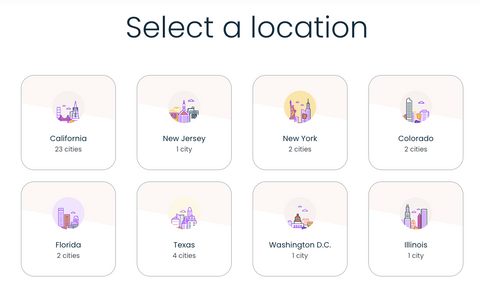How to manage hybrid teams: Tips & strategies to follow
 GroWrk Team
GroWrk Team
In August 2021, Bamboo HR conducted a survey with 1,000 US Adults who returned to the office. 37% said they felt worse in the office than even their lowest point in the pandemic.
61% of workers hoped for more in-person collaboration but only 49% actually reported experiencing it. 54% of workers thought productivity would go up, but only 35% said they experienced this.
What we are seeing here is a complete disconnect between the expectations of companies and their employees.
Employers have rushed the return to the office without making any fundamental changes to the spaces or processes and expect their workers to be as happy as they are.
Employees have spent the last year and a half working remotely and they have gone back to a workplace that hasn't changed since 2019.

We spoke with Liza Mash Levin, The CEO and Co-founder of Gable, a platform for finding and managing co-working spaces to hear her perspective on navigating the new reality of hybrid teams.
How did you get interested or introduced to hybrid work? Why did this lead you to start Gable?
Before I started Gable, I was a remote employee and manager myself. I worked with and managed remote teams across the globe, and it struck me how incredibly effective, cohesive, and productive these teams were.

What are your recommendations for implementing a flexible work policy?
I don’t think strict mandates of any kind will work well with employees in the long run. Flexibility means trusting your people to know where and when they are most productive and giving them the option to exercise that judgment.
On the other hand, when talking to hybrid teams, I did notice one thing: most hybrid teams that use Gable have a dedicated day or two when they meet in our spaces.

So, on the one hand, everyone can use the flex spaces to go out and work by themselves, but when it comes to gathering, there are specific days for that.
Combining these two approaches and giving employees the option to choose between focused work and meeting their team is probably the golden mean.
How can managers balance their evaluation and assistance between remote and hybrid workers?
And how can they prevent favoritism or bias to the people they always see in the office and those that prefer working from home most of the time?
The one thing we know for sure about the new workplace is that it isn’t one-size-fits-all anymore. For example, some employees work remotely because the company is distributed and hires across the US.
In those cases, providing equal access to workspaces for employees in Utah as those in NYC is by itself leveling the playing field.

On the other hand, the hybrid and remote work models require setting up new procedures to avoid the “out of sight, out of mind” scenarios. As a manager myself, I emphasize transparent communication, regular check-ins, and team bonding activities.
What is the best way to conduct a hybrid meeting?
Conducting meetings in general has become an art form, but when the team is hybrid, it’s the details that make all the difference.
So apart from providing a clear agenda and always taking minutes, I’d say the best way to conduct a hybrid meeting is to make sure everyone dials in separately.

I’ve had situations where part of our team is together in a Gable space in San Francisco, and the rest of our team is remote.
Even in these cases, I make sure that everyone dials in so the team feels equally included regardless of their location.
How do managers get the most out of their office or co-working space?
What tactics would you recommend to improve collaboration and avoid returning to heads-down cubicle behavior?
I don’t think employees will go back to cubicle behavior at all. After the past two years, people are very eager to go back to the office, but they absolutely don’t want to sit there at their laptops all day.
When people do come to a space, what they want is to engage with their team, exchange ideas, have discussions, brainstorm, and collaborate.

What managers should do to leverage their workspaces is to foster and encourage those desires in their employees, especially in distributed teams.
Providing every employee with a workspace in their city and an easy way to book and use that space is a great start.
How can managers encourage people to understand their productivity in this new world of work?
This is a great question, and I think it’s actually twofold. Welcoming newcomers into a hybrid team relies once again on the systems and processes you set up for everyone.
It boils down to how and when people communicate, how much of the work is done asynchronously, and of course, encouraging people to log off and enjoy their off-hours.

On the other hand, managers, especially in the HR and People Ops functions, need to understand and measure the effects of the hybrid workplace on their employees’ productivity and satisfaction.
Having the data and knowledge about how often people meet to work together, whether that increases productivity, which teams meet often - these are the metrics that inform decision making and give companies the necessary overview of how hybrid works for them.
How can companies and managers use the workspaces at Gable to maximize their employees and team experience?
During this year, Gable has grown exponentially, so apart from having 300+ spaces across the US, we now have a great dashboard we developed specifically for our enterprise customers and their distributed teams.
Through our dashboard, managers can add cities and locations they want to make available to their employees, assign monthly usage limits and budgets, and monitor the usage and expenses in real-time.

Source: gable.to
Most importantly, managers can see how employees rate their productivity and satisfaction and get a clear picture of how and why employees use the spaces.
On the same platform, employees can book the spaces, invite colleagues to join them, and see who else is coming to a space on a particular day.
With Gable, both employees and managers have access to workspaces across the country, a whole new level of visibility, and insights into metrics that count.
Wrapping up
If you are still struggling how to set up your hybrid office make sure to take a look at the Gable blog where they have a ton of great resources to help.
Another place to look is at the experience of other companies who have been experimenting with different hybrid setups.
Loom recently opened their San Francisco office on a voluntary basis (no mandate), here is what their Head of People Ops found:
- Of employees who live within commute distance, only 56% came in at least once during the quarter.
- Only 6% employees came in more than twice a week. And this hasn't changed as COVID numbers have dropped.
- They have peak days where 25-30% of employees come in to collaborate and hang out (typically on Wednesdays and Thursdays).
Their office has primarily become a social and collaborative space. Check out some photos of how they imagine their new "Clubhouses."

Source: Loom.com
Biggest takeaway from Loom's experience, Liza's knowledge, and those who responded to the Bamboo HR survey: Let your employees guide your hybrid future!
Just give them the support, tools, and flexibility they need.
Grow remote with GroWrk. We provide a unified and centralized platform to manage, secure and maintain laptops, devices, other IT equipment and services to remote teams in over 150 countries.





